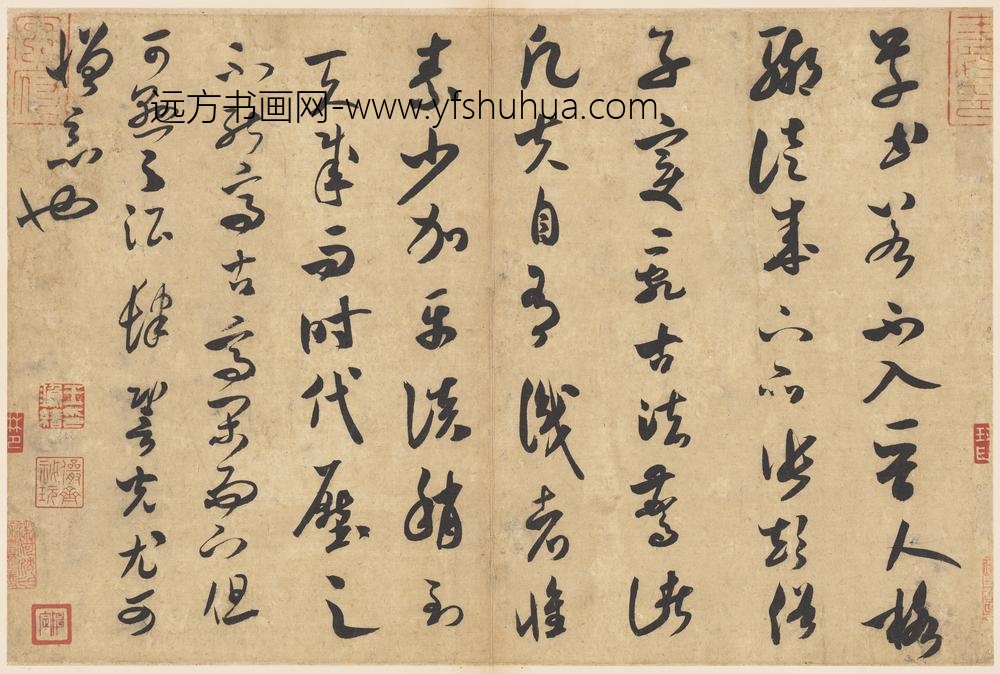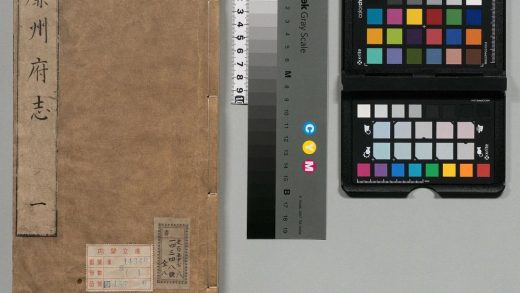【作品基本信息】
| 作者 | 米芾 |
| 品名 | 宋四家真迹册-书论书 |
| 朝代 | 北宋 |
| 文件大小 | 18.0MB |
| 分辨率(DPI) | 300×300 |
| 像素大小 | 2983×2012 |
| 尺寸(CM) | 25.25×17.03 |
| 作品数量 | 1 |
| 作品收藏 | 台北故宫博物院 |
| 图片格式 | 默认提供TIF和JPG两个版本 |
基本数据
| 藏品类型 | 书法 |
| 品名 | 宋四家真迹 册 宋米芾书论书 Discourse on Calligraphy |
| 分类 | 法书 |
| 作者 | 米芾;Mi Fu |
| 书体 | 草书 |
| 数量 | 一幅 |
| 作品语文 | 汉文 |
| 释文 | 草书若不入晋人格。輙徒成下品。张颠俗子。变乱古法。惊诸凡夫。自有识者。怀素少加平淡。稍到天成。而时代压之。不能高古。高闲而下。但可悬之酒肆。𧦬光尤可憎恶也。 |
典藏尺寸
| 【位置】 | 【尺寸】(公分) |
| 本幅 | 24.7×37 |
| 全幅 | 42.1×71.3 |
质地
| 【质地位置】 | 【质地】 |
| 本幅 | 纸 |
印记数据【印记类别】【印记】收传印记王鸿绪印收传印记俨斋秘玩收传印记陈定收传印记内府书印(半印)收传印记琳印(半印)收传印记淛河沈氏勖礼彦敬敬斋图书秘玩之印(重一。皆为半印)收传印记内府书印(半印)收传印记琳印(半印)
参考数据
| 【类别】 | 【参考数据】 |
| 收藏着录 | 石渠宝笈续编(重华宫),第三册,页1672-1676 |
| 收藏着录 | 故宫书画录(卷三),第一册,页146-151 |
| 收藏着录 | 故宫历代法书全集,第十一册,页40-63、193-195 |
| 参考书目 | 1.何炎泉,〈宋四家真迹 册 宋米芾书论书〉,收入林柏亭主编,《大观-北宋书画特展》(台北:国立故宫博物院,2006年初版一刷),页318-325。 2.黄纬中,〈米芾〈论书帖〉辨字〉,《故宫文物月刊》,第159期(1996年6月),页119-125。 3.何炎泉,〈从米芾〈论书〉帖看他与高闲、韩愈之间的关系〉,《故宫文物月刊》,第274期(2006年1月),页50-61。 |
| 内容简介(中文) | 米芾(公元一○五一-一一○七年),字符章,湖北襄阳人。历官校书郎、安徽无为军知事。精于见赏,徽宗时诏为书画学博士,得以遍观内府秘藏。 本幅论草书一则,以晋人书风为最高目标,对唐代草书大家张旭、怀素、高闲及訾光均有微词,为崇晋抑唐之论调,常见于米氏书论。本幅书风全宗二王,不涉唐人狂草一笔,可见其理论与实践确实相辅相成。本幅选自「宋四家真迹」册。 |
| 内容简介(中文) | 米芾(一0五一- 一一0七), 湖北襄阳人. 字符章, 历官校书郎、安徽无为军知事. 由于他精于鉴赏, 徽宗朝初期诏为太常博士和书画学博士, 得以遍观内府所宝秘藏. 五十七岁卒于知淮阳军任上. 本幅论草书一则, 以晋人书风为最高目标, 对唐代草书大家张旭、怀素、高闲及 光均有微词, 此为崇晋抑唐之论调, 常见于米氏书论. 本幅书风则全宗二王, 不涉唐人狂草一笔, 足见米芾之理论与实践确系相辅相成. 本幅选自「宋四家真迹」册. |
| 内容简介(英文) | Mi Fu, a native of Hupeh, served as an official in the Northern Sung. As a skilled calligrapher, painter, and connoisseur, he was appointed Doctor of Painting and Calligraphy under Hui-tsung (r. 1101-1125), thereby giving him the opportunity to examine the treasures in the imperial collection. This work is part of a discourse on cursive script. Taking the calligraphy of the Chin dynasty (265-420) as the standard, Mi Fu’s contents include a hint of criticism for the cursive script of such T’ang dynasty (618-907) calligraphers as Chang Hsu, Huai-su, Kao Hsien, and Tzu Kuang. Admiration for the Chin over the T’ang is often seen in Mi Fu’s discourses on calligraphy. Since this work is completely in the manner of the Two Wangs of the Chin (Wang Hsi-chih and Wang Hsien-chih) without a hint of the wild cursive of the T’ang, it shows that Mi Fu indeed “practiced what he preached.” This work is from the album “Authentic Works by the Four Sung Masters.” |
| 内容简介(中文) | 米芾(1052-1108),字符章,湖北襄阳人,历官校书郎、安徽无为军知事。精于鉴赏,徽宗时诏为书画学博士,得以遍观内府秘藏。此帖文字内容论及草书的品评,以晋人书风为最高标准,对唐代草书大家张旭、怀素、高闲等颇有微词。类似的崇晋抑唐论调,也经常见诸于米芾的书论文字中。本幅全以晋人今草风格书写,带着平淡天真的古雅气息,舍弃唐人狂草的笔法,在书风表现与文字内容上契合一致。(20061206) |
| 内容简介(英文) | Mi Fu, style name Yuan-chang, was a native of Hsiang-yang in Hupeh. In office, he served in the posts of Editor and Administrative Clerk of the Wu-wei Command in Anhwei. An excellent connoisseur, he was appointed as Erudite of Painting and Calligraphy under Emperor Hui-tsung (r. 1101-1125), giving him the opportunity to peruse the imperial collection. This work is a discourse evaluating cursive script. Taking that of the Chin dynasty as the highest standard, the contents include a hint of criticism for the cursive script of such T’ang masters as Chang Hsu, Huai-su, and Kao-hsien. A similar tone of admiration for the Chin over the T’ang is also often seen in Mi Fu’s discourses on calligraphy. This work is completely in the manner of Chin cursive script with a somewhat archaic elegance of purity and innocence. Forgoing the wild cursive manner of T’ang calligraphers, the style here accords well with the contents, showing that Mi Fu “practiced what he preached”.(20061206) |
| 内容简介(中文) | 米芾(公元一○五一-一一○七年),字符章,湖北襄阳人。历官校书郎、安徽无为军知事。精于鉴赏,徽宗时诏为书画学博士,得以遍观内府秘藏。 本幅论草书一则,以晋人书风为最高目标,对唐代草书大家张旭、怀素、高闲及辩光均有微词,为崇晋抑唐之论调,常见于米氏书论。本幅书风全宗二王,不涉唐人狂草一笔,以实践印证其理论。本幅选自「宋四家真迹」册。 (20121017) |
| 内容简介(英文) | Mi Fu (style name Yuanzhang) was a native of Xiangyang, Hubei. In office, he served as Editor and Administrative Clerk of Wuwei Command in Anhui. An excellent connoisseur, he was appointed Erudite of Painting and Calligraphy under Emperor Huizong, giving him access to the imperial collection. This work is a discourse on cursive script. Taking Jin dynasty cursive as the highest standard, Mi is critical of such Tang masters as Zhang Xu, Huaisu, Gaoxian, and Bianguang. A similar admiration for Jin over Tang cursive is often seen in Mi’s discourse on calligraphy. This work fully in the Jin manner of the Two Wangs without any Tang “wild cursive” shows that Mi “practiced what he preached.” It is from the album “Authentic Traces of the Four Song Masters.” (20121017) |
| 参考书目 | 吴诵芬,〈宋四家真迹 册 宋米芾书论书〉,收入刘芳如主编《遗珠-大阪市立美术馆珍藏书画》(台北:国立故宫博物院,2021.08),页78-79、268-269。 |
【作品展示】


册-元赵孟頫书归去来辞并序-1-520x293.jpg)


